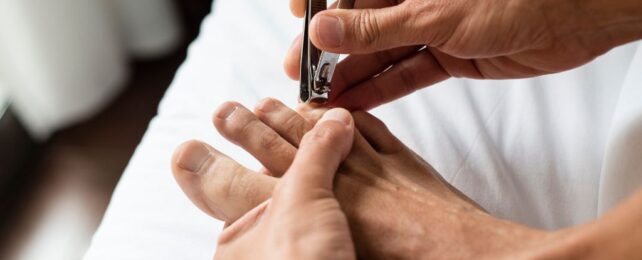A radioactive gas that gets trapped in indoor spaces accounts for 3 to 14 percent of all lung cancers – and our toenails could reveal our long-term exposure to this gas.
Radon, a colorless and odorless gas, is the second-leading cause of lung cancer after tobacco smoking, and yet non-smokers and occasional smokers often do not qualify for a lung cancer screening.
A team of scientists from the University of Calgary in Canada have found a surprisingly simple way to detect a person's long-term exposure to radon, which may help doctors identify this missing cohort of people who are at risk of lung cancer, even though they have never picked up a cigarette, rarely smoked or quit long ago.
Related: An Early Warning Signal of a 'Silent Killer' Cancer May Hide in Your Poop
Toenails are one of the body's 'archives' of our long-term exposure to environmental toxins like radon. In a proof-of-concept study, the interdisciplinary team, led by biochemist Aaron Goodarzi and physicist Michael Wieser, show that toenail clippings are reliable indicators of long-term radon exposure.
If validated through further studies, this could help patients in overlooked but at-risk groups access potentially life-saving lung cancer diagnostics.
"After you inhale radon, it quite quickly transforms into a specific type of radioactive lead. Your body treats radioactive lead from radon like it does all lead and stores it in slow-shedding tissues such as the skin, hair and nails," Goodarzi explains.
"We tested for lead isotopes in toenail cuttings and proved they can serve as a quantitative method to reveal lifetime radon exposure at an individual level," says Wieser.
Unlike smoking history, radon exposure isn't something that's easy for a patient to self-report. Often, people are unaware that they've ever encountered this gas, and exposure differs depending on local geology, and the way indoor spaces are built and used.
Building codes have been established to address this, but they may not apply in certain countries, or may not have been implemented in older buildings.

Radon (Rn) is naturally produced in the ground, and releases into the air. In outdoor spaces, it easily dilutes away, but indoors, it can accumulate quickly. That's especially the case in buildings with poor ventilation and in cold places, where pressure differences can pull more radon from the ground into indoor spaces.
Radon can also dissolve in, accumulate and be released from water, especially in uranium-rich rural areas where groundwater is an important source. Some building materials also contribute to indoor radon accumulation, including lightweight concrete with alum shale, phosphogypsum and Italian tuff.
"In some regions of high geologic radon potential, such as Canada, more recent residential building practices have unintentionally worsened radon exposure," the team writes, "whilst evolving trends in work has, for some professions, increased yearly time spent breathing the indoor air of the residential built environment."
Using ultrasensitive methods, the researchers detected 210Pb, a lead isotope that results from radon decay, in 39 of the 55 toenail samples they analyzed (71 percent).
Adults who had been inhaling elevated radon levels in their homes for an average of 26.5 years had about 0.298 femtograms of 210Pb per nanogram of stable lead locked up inside their toenail cuttings.
Meanwhile, the toenails of those who had low exposure to radon across the years contained only 0.075 femtograms of 210Pb per nanogram of lead.
That's a 397 percent difference: a pretty strong indicator that your history of radon exposure is, indeed, written in your toenails.
What's also helpful is that elevated radon levels were still detectable in the toenails of people up to six years after they had made changes to their home to reduce their high radon exposure.
A much larger validation trial is now underway to ensure the method holds up across a much wider and more diverse population. The researchers are seeking 10,000 Canadian residents willing to test their homes for radon, and send a few toenail clippings in for sampling.
"The data will form the evidence that could lead to the inclusion of more patients, whose lung cancer is not caused by tobacco smoke, in potentially life-saving early screening and diagnosis," says Goodarzi.
This research was published in Environment International.
